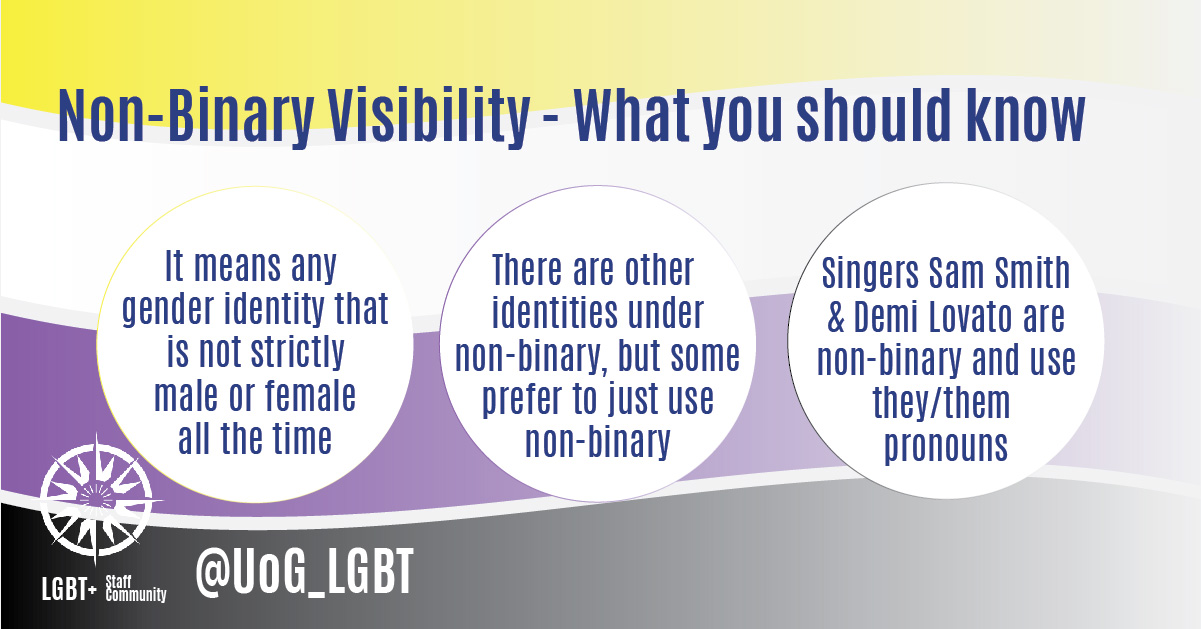Since 2012, every year on 14 July International Non-Binary People’s Day has sought to increase public awareness, knowledge and understanding of issues faced by non-binary people whilst celebrating the rich diversity of gender outside binary constraints. Whilst lesbian, gay, bisexual and transgender (LGBT+) identities have seen increased visibility, gender identity outside or in-between traditional masculine and feminine social expectations may be something you are unfamiliar with. Well, have no fear as we are going to introduce you to the fabulous world of gender diversity by answering five common questions about non-binary identity.
What is non-binary identity?
Non-binary gender identity is an umbrella term people may use when their gender identity fits neither ‘man’ or ‘woman’ (Stonewall, 2021). Non-binary identities are varied and, whilst some people may relate with certain characteristics or aspects of a binary gender, others reject this entirely (Mermaids, 2021). You may also hear a non-binary identity called agender, genderqueer or genderfluid and, whilst these terms do not mean exactly the same thing, they do relate to experiencing gender that is not simply male or female. Titles such as Mx and pronouns such as They/Them are commonly used.
 Is non-binary identity something new and trendy?
Is non-binary identity something new and trendy?
Absolutely not - gender identity has existed outside the binary categorisation and is seen across time and different global cultures (Herdt, 1996). Although the Office for National Statistics states that there are no official figures for non-binary identities, recent census figures show 0.4% of respondents failed to give a binary response to ‘Sex’ meaning approximately 1 in every 250 people may identify outside binary gender classification (Practical Androgyny, 2014). It is worth recognising that, although culturally gender divergent people have existed long before us, no current law, such as The Equality Act 2010, protects people who are non-binary.
How can I tell if someone is non-binary?
You cannot tell if someone is non-binary simply by looking at them (National Centre for Transgender Equality, 2018). Whilst we have socially conditioned expectations of what a man or woman is (Lindsey, 2015), these are often highly stereotypical portrayals of gendered ideals. Since we cannot tell if someone is non-binary by physical appearance, ‘ask etiquette’ - where you simply ask what terminology someone prefers and how they experience their gender - is an inclusive and affirmative approach to take (Richards & Barker, 2013).
What can I do to be an ally?
Being an ally is a constant process; think of it as a verb. You do not have to have a total understanding of non-binary identity to respect people. We can all practice allyship by incorporating the following tips into our everyday lives:
- Include your own pronouns when introducing yourself.
- Try not to make assumptions about someone’s gender.
- Not sure what pronouns someone uses? … Ask them.
- Use the correct name and pronouns for people even when they are not there.
- Advocate for inclusive non-binary policies.
- Talk to non-binary people to learn more about who they are.
- Challenge unacceptable behaviour wherever possible (when you feel safe to do so).
What do I do if I make a mistake?
We all make mistakes; intent will be clear and if you are trying your best to support non-binary people but do slip up you can apologise, recognise to them that you have made a mistake, state that you will try harder and move on. Remember it is not the responsibility of the person you may accidently misgender to make you feel better.
We hope this short piece has provided you with an introduction to non-binary identity and that you will now feel more confident navigating the world of gender diversity!
The LGBT+ Staff Community recognises that many, including and perhaps most especially those in the LGBT+ community, are learning in this specific area and need to do more to demonstrate inclusivity of marginalised or underrepresented LGBT+ groups. That is why we have invited the LGBT Foundation Training Academy to deliver an online session for the community group and colleagues on trans and non-binary inclusion as part of raising awareness today.
Connect with our Communities
LGBT+ Staff Community
A community of staff and allies supporting the development of LGBT+-related equality and diversity support and representation within the university. If you identify with, or as an ally of, lesbian, gay, bisexual, trans and wider non-heteronormative identities, you are welcome to join the Community.
Membership is open to all permanent and temporary staff working at the university, including outsourced staff.
Contact lgbt@gre.ac.uk for more information and advice, and follow @UoG_LGBT on Twitter for event updates.
Women’s Staff Network
The network represents Academic and Professional Services staff and welcomes trans women and non-binary females.
You can contact the network and join their events through the Women's Staff Network webpage.
LGBTQ+ Student Network
Enabling members of the LGBT+ student community to come together to share information, provide support and discuss concerns and problems.
Email Bradie McDaid, Greenwich Students’ Union (GSU) Liberation Organiser for LGBT+ students, or follow Instagram @liberationgsu or keep an eye out for more information about the network on the GSU website for information on how to get involved.
LGBTQ+ Student Society
Supporting students regardless of how they identify. The society supports and develops the LGBTQ+ student community at the university and provides a safer, more welcoming, and ultimately happier space for LGBTQ+ people.
Join the Facebook group for more information.
Connect with other community groups, services and sources of advice and support
- University of Greenwich Employee Assistance Programme
- University of Greenwich Student help and advice
- MindOut - LGBTQ+ mental health service
- Mind.org - useful contacts for LGBTIQ+ mental health support
- Stonewall - Help and advice
- Student Minds - LGBTQ+ resources
Find out more
- Add a LGBT+ Background to your Teams call
- Practical support for trans and wider equality
- What LGBT+ Allyship means to me
- LGBT+ Allyship: What does it mean to be an ally, not a bystander?
- International Day Against Homophobia, Transphobia and Biphobia - 17 May
- Celebrating Trans Day of Visibility - 31 March
- Marking Pride Month at the university
- Celebrating LGBT+ History Month in February
References
Herdt, G. (1996). Third sex third gender. New York: Zone.
Lindsey, L.L. (2015). Gender Roles: A Sociological Perspective (6th ed.). Routledge.
Mermaids (2021) Homepage [online] available at: https://mermaidsuk.org.uk/
National Centre for Transgender Equality (2018) Understanding Non-Binary People: How to Be Respectful and Supportive [online] available at: https://transequality.org/issues/resources/understanding-non-binary-people-how-to-be-respectful-and-supportive
Practical Androgyny (2014) How many people in the UK are non-binary [online] available at: https://practicalandrogyny.com/2014/12/16/how-many-people-in-the-uk-are-nonbinary/
Richards, C., & Barker, M. (2013). Sexuality and gender for mental health professionals: A practical guide. London: Sage.
Stonewall (2021) Glossary of Terms [online] available at: https://www.stonewall.org.uk/help-advice/faqs-and-glossary/glossary-terms
Danielle J. Roe (She/her/hers) @DJROE95
Max Davies (They/them) @MaxDavies_PHD

